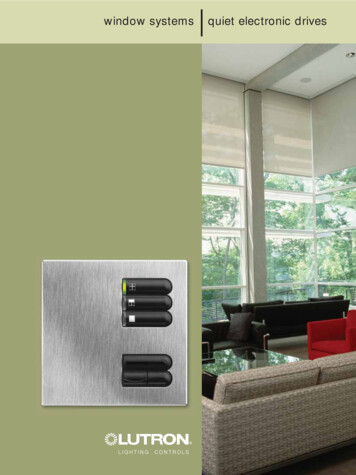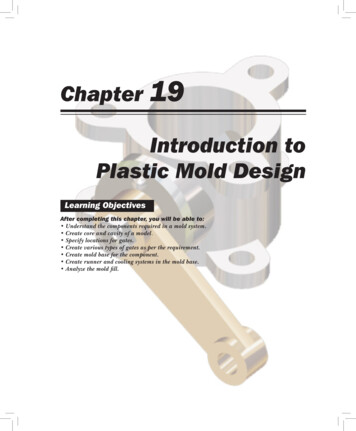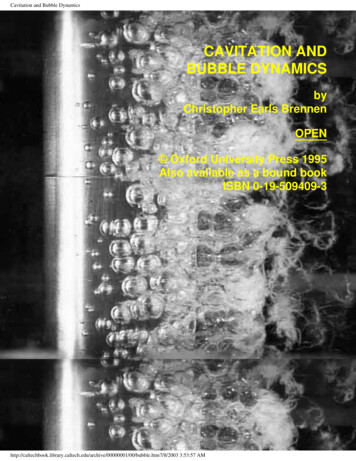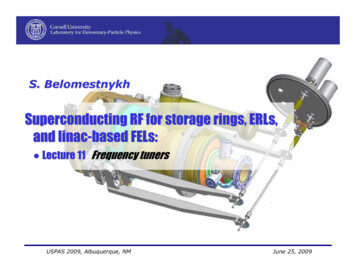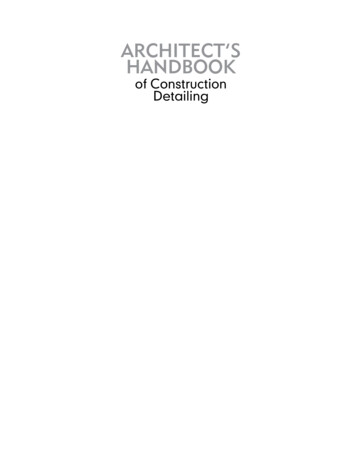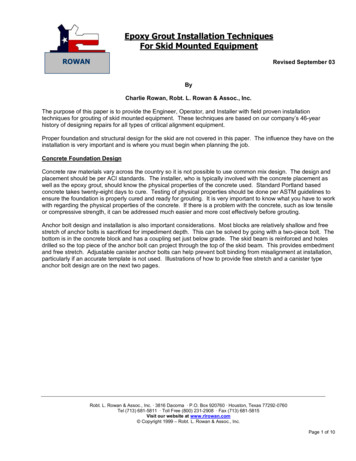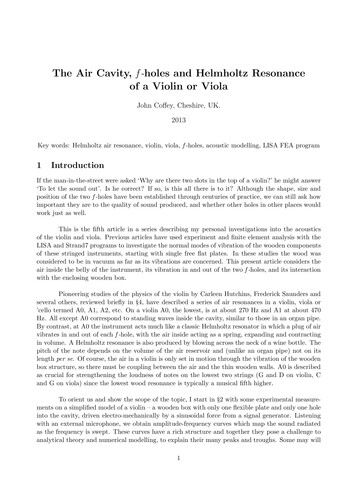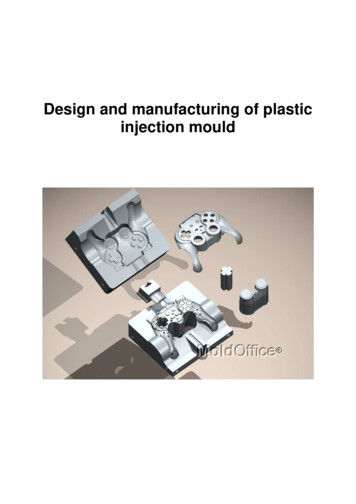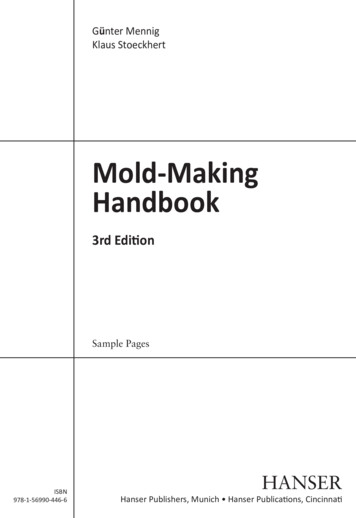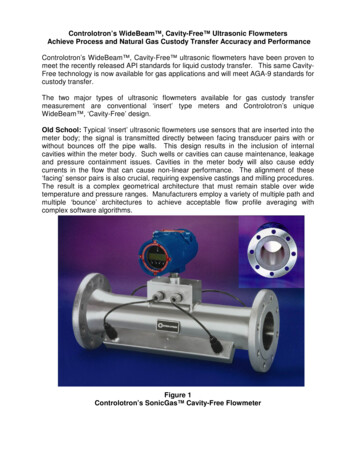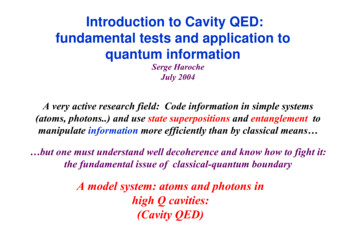
Transcription
Introduction to Cavity QED:fundamental tests and application toquantum informationSerge HarocheJuly 2004A very active research field: Code information in simple systems(atoms, photons.) and use state superpositions and entanglement tomanipulate information more efficiently than by classical means but one must understand well decoherence and know how to fight it:the fundamental issue of classical-quantum boundaryA model system: atoms and photons inhigh Q cavities:(Cavity QED)
Course outline1.A reminder about concepts and an overview ofexperiments: how to entangle atoms and photons andrealise quantum gates2.Exploration of the classical-quantum boundary with fieldcoherent states: Schrödinger cats and decoherencestudies
First lecture1.1 A reminder about entanglement, complementarity anddecoherence1.2 A brief survey of quantum information1.3 A testing ground: microwave cavity QED1.4 Entanglement and gate experiments in CQED1.5 An introduction to cat state studies in CQED
Entanglement: non-separability of quantumphysicsABΨAB ΨA ΨBρΑ TrB( ΨAB ΨAB )« Entanglement is theessence of thequantum »(Schrödinger, 1935)
Entanglement survives to spatial separation of system’s parts(Einstein, Podolsky and Rosen 1935: EPR paradox)The non localityof quantumphysics cannotbe understoodin alviolation oftheseinequalitiesvindicatesquantummechanics
Entanglement is «strange» because never observed in macroworld .Schrödinger Catparadox (1935)The atom evolves in a state superposition What is then the state of thcat before the box is opened? Is it entangled with the atom?A cat coherently suspended between life and death?Problen linked tomeasurement theory(entanglement betweenmicro-system andapparatus)
What happens to Schrödinger Cat? Itgets entangled to its environment!(Decoherence)The cat’s « wave function » has nomeaning (replaced by density operator!)Situation linked to complementarity: quantum interferences aredestroyed if information about the system’s path leaks intoenvironment:Simple illustration with Young double slit
Decoherence, entanglement with environment and complementarityIn Young ’sexperiment, thescattered photon getsentangled with theparticle ’s path: itsdetection pins downthe particle ’s stateand destroys allquantum interferencesIn Schrödinger’s« experiment », the thermalbath gets entangled withcat. Information about itsfate very quickly leaks intoenvironment, destroyingquantum coherencesDecoherence transforms « quantum » into « classical or »:Environment acts as a spy lifting quantum ambiguity. « Bad entanglement » withenvironment kills « good entanglement » with single atom. Decoherence occursfaster and faster as size of system increases (Zurek, Physics Today, Oct 91)
First lecture1.1 A reminder about entanglement, complementarity anddecoherence1.2 A brief survey of quantum information1.3 A testing ground: microwave cavity QED1.4 Entanglement and gate experiments in CQED1.5 An introduction to cat state studies in CQED
What can entanglement do for us ?(provided environment is kept in check)Information can be coded in two state particles (quantum bits or qubits)and « entangled information » can be. shared securely between two parties (quantum cryptography). used to « teleport » the unknown quantum state of a particle. manipulated by quantum logic gates in order to explore thepossibilities of quantum computing.
Computing with quantum logictimeControl bit a b Target bit a Not a b A quantum gate couples two qubitsthrough a conditional unitary operation(if A is true, then do B.).Here the CNOT gate:if the control bit is 1, flip the target bit(performs addition modulo 2 of the twoqubits in the target output and leavescontrol unchanged)Universal gateA quantum gate can generate entanglement (if control in state superposition):( 0 1 ) 0 0 0 1 1 Combining gates opens in principle fantasticperspectives for computation (massiveparallelism and interference ofoutputs.) but beware of decoherence(this is a very large Schrödinger cat!)The dreams: factorizing large numbers (Shor),sorting data in a large basis (Grover) .
Requirements for implementing quantum logicEfficient manipulation and read out of individual two state particlesStrong coupling between particles (fast gate operation)Weak coupling to environment (slow decoherence)Scalability: possibility of juggling with many particlesMany qubit candidates .but no ideal one so farNuclear spins inmoleculesPhoton pairs andbeam splittersSuperconductingcircuitsIons intrapsAtoms incavitiesQuantumdots
First lecture1.1 A reminder about entanglement, complementarity anddecoherence1.2 A brief survey of quantum information1.3 A testing ground: microwave cavity QED1.4 Entanglement and gate experiments in CQED1.5 An introduction to cat state studies in CQED
The Qubit candidates:4. Atoms and photons in cavitiesExperimentsat ENS,Paris.AlsoGarching,Caltech.Qubit realized either by atom (in e or g state) or byphoton field (0 or 1 photon in cavity)A simple system to learn how to manipulate quantum informationIncreasing complexity one atom or one photon at a time: frommicroscopic to mesoscopic worldFor a review of ENS work, see Raimond, Brune andHaroche, RMP, July 2001
Two essential ingredientsCircular Rydberg atomsLarge circular orbitStrong coupling to microwavesn 51n 50Long radiative lifetimes (30ms)Level tunability by Stark effectEasy state selective detectionQuasi two-level systemsSuperconducting mirror cavityGaussian field mode with 6mm waistLarge field per photonLong photon life time improved by ring around mirrors (1ms)Easy tunabilityPossibility to prepare Fock or coherent states with controlledmean photon number
General scheme of the experimentsRev. Mod. Phys. 73, 565 (2001)
An essential tool: the Quantum Rabi oscillationRealizes controlled atomfield entanglement whichsurvives after atom leavescavity (EPR situation)Couplage fort:Ω 1/Τcav, 1/Τat3.105 s-1 103 s-1, 30 s-1
First lecture1.1 A reminder about entanglement, complementarity anddecoherence1.2 A brief survey of quantum information1.3 A testing ground: microwave cavity QED1.4 Entanglement and gate experiments in CQED1.5 An introduction to cat state studies in CQED
Entangled atom-atom pair mediated by real photon exchangeV(t)g2e1Electric field F(t) used totune atoms #1 and #2 inresonance with C for adetermined time t realizingπ/2 or π Rabi pulseconditionsHagley et al, P.R.L. 79,1 (1997)
Direct entanglementof two atoms viavirtual photonexchange:a cavity-assistedcontrolled collision(after S.B.Zeng and G.C.Guo, PRL 85,2392 (2000)).realizes aquantumgate
A special situation:A 2π Rabi pulse inducedby one photon in onearm of interferometerflips by π the phase offringes: QND detectionof single light quantum
Quantum Non Demolition measurement of a photonG.Nogues et al, Nature, 400, 239 (1999)Single photon in C dephases fringeson0 photonR21 photonR2Phases adjusted sothat atom exits in onestate if there is 0photon in C, in theother if there is 1photon (2π Rabi pulsein a one photon field)Energy is exchanged with Ramsey classical fields, not withquantum field: QND method with atom acting as a metermeasuring the field Also a quantum gateIf initial field is in a superposition of 0 and 1 photonstates, the process generates entanglement
An experiment with two or three atoms: generation and nondestructive measurement of a single photonPulse de Rabiπ/2 sur atome 1Pulse de Rabi2π sur atome 2 First atom (« source ») emits with 50% aphoton in C. Subsequent atomic detectionprojects field in 0 or 1.Second atom (meter) « reads »photon number by RamseyinterferometryPhoton is readwithout beingerased ( a thirdatom still « sees » itas shown below)
Combining Rabi pulses to « knit » multiparticle entanglement2π Rabipulse (QND)π/2 Rabi pulse First atom prepares a photon with 50% probability (π/2 pulse) andsecond atom reads it by QND method (2π pulse)π Rabi pulse Three particle engineeredentanglement(Rauschenbeutel et al,Science, 288, 2024 (2000) A third absorbing atom (π pulse) also reads the photon,resulting in three atom correlations
First lecture1.1 A reminder about entanglement, complementarity anddecoherence1.2 A brief survey of quantum information1.3 A testing ground: microwave cavity QED1.4 Entanglement and gate experiments in CQED1.5 An introduction to cat state studies in CQED
Dispersive entanglement in non-resonantCavity QEDAtom and cavity off-resonant by amount δNo photon absorption or emission .but atomic transition and cavity mode exhibitfrequency shifts (single atom index effect)Sign of effect( ω or ω)depends uponenergy state(e or g)When atom is sent in state superposition, isthe shift ω or ω?Ambiguous quantum answer leads todispersive atom-field entanglement
Entanglement involving mesoscopic fieldstates with different phases(Brune et al, P.R.L. 77, 4887, 1996; S. Haroche, Physics Today, July 1997)15 to 40 photonsBy increasing the field ’samplitude in C, we canexplore the quantum classicalboundaryVacuumKittenMesoscopic catIncreasing average photon number
The Cavity QED group atENS and Collège de FrancePhD students:Alexia AuffevesSerge HarocheMichel BruneJean Hare*Valérie Lefèvre*Gilles NoguesJean-Michel RaimondPatrice BertetPostdoc:Perola MilmanPhilippe HyafilVisiteurs:Romain Long* (Paris - Munich)Luiz DavidovichPaolo MaioliNicim ZaguryTristan MeunierJohn MozleyStefano OsnaghiArno Rauschenbeutel (à Bonn depuis 2001)Sébastien Steiner*C NRS, CE et JST (Japon)(Rio de Janeiro)
quantum information Serge Haroche July 2004 A very active research field: Code information in simple systems (atoms, photons.) and use state superpositions and entanglement to . of quantum physics cannot be understood in classical terms (Bell's inequalities). The experimental violation of these inequalities vindicates quantum

